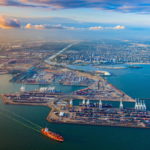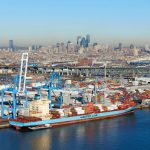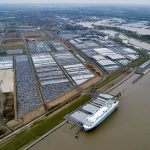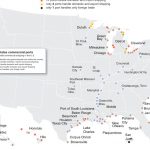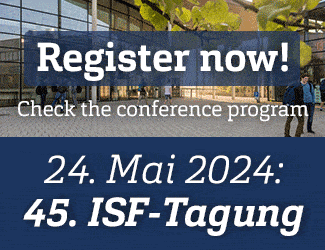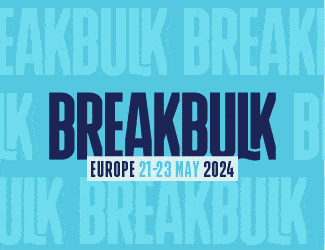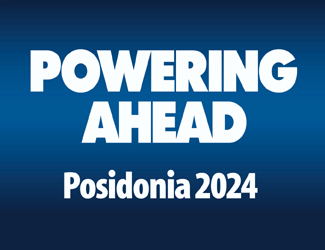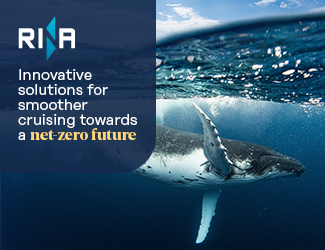Protectionism? Trade war? Investment! Regardless of economic uncertainties, US ports are confident in their future as large investments prove. Hardly any player in the maritime industry wishes to comment on the new government. By Michael Meyer
According to the American Association of Port Authorities (AAPA) seaport activity supports 23mill. US jobs and generates 321 bn $ in[ds_preview] federal, state and local tax revenue each year. The total value of economic activity related to America’s seaports is 4.6 tn $, representing 26% of the US economy. However, these figures apply to the time prior to the new federal government. The new US president wants to boost the exports of the US economy and even push them into new dimensions. This is good for the ports, especially those who are active in the export of oil and oil products. Further facilitations for exporters are to follow.
After the first few weeks in office, the new government’s legacy is, above all, the withdrawal from free trade as practiced so far. Trump put the US involvement in the transpacific TTIP agreement into the trash bin and challenged the North American NAFTA agreement. The transatlantic counterpart TTIP is also frozen for an indefinite period. TTP and TTIP would have allowed the US ports to profit from additional cargo volumes.
According to official data, Donald Trump is by no means heading towards foreclosure. He is rather striving for a reorganization of global trade patterns. »We are still going to trade, but we are going to have fair trade,« Trump said after the election.
However, it could become problematic if other countries react to US import tariffs with import duties on their part. A scenario which may not only involve China but, for example, also Mexico. The country is the largest single importer of US oil products. According to the US Department of Energy, 80% of all gasoline imports are to be allotted to the U.S. Between 44% and 54% of all US gasoline has been exported to Mexico for the past five years. Trump will probably not scare off this trading partner.
The International Energy Agency IEA expects a rise in US shale oil production after a somewhat weaker 2017. Pipelines play a central role in trumps plans. However, if oil is transported from the north to the refineries in the south, the ports could benefit from additional export volumes. It is true that oil imports should be subject to duties, which in turn could reduce incoming volumes. However, these losses could be compensated by new export volumes, experts say, possibly even more than compensated. This should also apply to other types of goods.
At this point, however, some shipping companies are concerned. The Danish shipping giant A. P. Mœller Mærsk warns of a US-Chinese trade war, for example. CEO Soren Skou fears negative effects on the Group’s business. In container shipping, Maersk operates 21 North American services, and thus the owner ships 10% of all inbound and outbound US container loads, Maersk confirmed to HANSA. As far as trade policy is concerned, Maersk Group remains vague: »We do not comment on politics, however as a shipping company we are in favour of the free movement of goods and international trade. We believe trade contributes to prosperity and development, globally and locally. While it is regrettable if broad support for unratified trade agreements cannot be mustered, this will not change the status quo for global trade.« The company added it was still too early to comment on the potential outcome of renegotiations of existing trade agreements.
The shipping organization Bimco recently warned of protectionist tendencies with a view to the container industry, which basically rather harm the shipping industry than promote it. »Bimco expects US-bound exports out of Asia to grow slowly, as the economic growth weakens in the US.«
Special significance is also attributed to sea-side vehicle transport. The Mexican car exports to the US have risen significantly in recent years, also thanks to the NAFTA trade agreement. Many European and American manufacturers produce in Mexico due to lower production costs. Around 3.4mill. cars were produced there in 2015, 2.3mill. thereof were sent to the US and Canada. The value of passenger cars exported from Europe to the US totalled some 41 bn € in 2015. Vice versa it was only 7 bn €. This is also owed to the better technological quality of European manufacturers.
The consequences of Trump’s trade policy are also an issue in this sector. Wallenius Wilhelmsen does not generally expect any serious consequences, despite the announcement that 35% border taxes on cars from Mexico will be levied. Roberto Zavala, Mexico’s head of the European car carrier giant, says: »We believe that trade between Mexico and North America will be positive in 2017 and beyond.«
Ultimately, general figures are only of limited relevance, and conclusions for the future development can only be drawn tentatively, because in some areas it is not clear, how the Trump government will decide and how the announcements made during the elections are actually enforced. Fundamental assumptions are possible.
The government and the maritime authorities have said only very little so far. Beyond mantra-like assurances to strengthen business and infrastructure extensively, there is little concrete. At the request of HANSA, they either refer to one another as the Federal Maritime Commission (FMC) under their new Chairman Michael Khouri, referring to Maritime Administration (MARAD), or they do not react at all like the powerful environmental authority EPA or the ministries for transport and trade. A press release by Trade Minister Penny Pritzker says that the ports are enormously important and that their effectiveness and productivity are of great national interest.
It is noteworthy that shortly after the election the government forbade some authorities to comment to the media – the incidents were made public via substitute Twitter accounts of the EPA and other authorities. Thus, transparency is a difficult task. One of Trump’s plans is to levy duties on imported goods from China. This is of great significance for the People’s Republic since 18% of all exports are alloted to the USA. It remains to be seen how Beijing will react to such measures – provided they will actually be implemented – and which implications for the transpacific trade and hence the port business will occur. In addition, the domestic energy industry is to be massively supported, for example, oil and coal subsidies are to be heated up in order to stimulate export. This could be a success.
AAPA does not speculate
And what is the situation with the relevant associations, which based on their very organizational structure would like to maintain a good relationship with the administration in order to maintain a certain degree of influence?
Responding to a HANSA request whether the new administration might have a significant effect on port business, AAPA-CEO Kurt Nagle says: »We aren’t speculating on the effects the new administration will have on trade policy.« The association has clear ideas which set screws are urgently needed.
According to Nagle, AAPA is hopeful that the Trump Administration’s pledge to invest 1 tn $ into the nation’s infrastructure over the next decade will result in improved transportation infrastructure in and around America’s seaports.
In a recently published paper, AAPA took position on the potential of policies intended to focus on local industries. The association said to favor »reciprocal international trade liberalization on a fair and equitable basis, supports new trade legislation which is consistent with US international obligations and has the effect of strengthening the President’s ability to expand US exports rather than creating new US import restrictions.«
In addition, AAPA favors continued US participation in comprehensive negotiations to expand trade in goods and services on a fair and equitable basis. It encouraged consideration of the economic and employment impact on seaports prior to imposing trade sanctions on imports from other nations.
AAPA-CEO Kurt Nagle emphasizes that freight connections to US ports are falling behind 21st century needs. On the landside »first and last mile« connectors like roads, railways, bridges and tunnels serve as vital links. But one-third of AAPA member ports say congestion at landside connectors has caused productivity to decline by 25% or more over the past ten years. Nearly 80% of ports in the US require at least 10mill. $ investment in their landside connectors through 2025; 31% require over 100mill. $.
According to the association, ports and their private sector partners are already contributing their share, and will invest more than 155 bn $ in modernization of infrastructure over the next five years. Yet, only 1.1 bn $ of 11 bn $ in freight infrastructure funding from the US Department of Transportation is eligible for multi-modal projects.
On the waterside the APAA criticizes that, while the Harbor Maintenance Tax (HMT) raises over 1.7 bn $ per year, chronic underspending has resulted in a surplus of more than 9 bn $ in the HMT Trust Fund – »at a time when critical maintenance needs and tax equity are not being addressed.« According to the American Society of Civil Engineers, failure to invest in the nation’s infrastructure could add 14 bn $ to the cost of traded products by 2040 due to shallow harbors and lead to a 9.3 bn $ trade loss from the use of undersized vessels in shallow harbors and narrow channels by 2020.
»By 2037, the US will export more than 52mill. shipping containers through US seaports each year,« Nagle says. Therefore, AAPA urges Congress and the new administration to support infrastructure policies that include robust freight transportation provisions and sustainable funding for the nation’s seaports. Recommended action for federal policy makers include landside investments to eliminate transportation bottlenecks as well as multimodal freight investments which are called »a key priority«. In addition, the association calls for action to modernize and maintain federal navigation channels through waterside investments.
The ports argue in a similar way. With a view to extended Panama Canal, they not only had their systems and fairways developed, but had also opted for modernization in the supposed certainty that free trade would not be touched. HANSA has asked some US locations about their expectations and plans. Not everyone wanted to answer. Those who did, emphasized above all the opportunities that could arise through the announcements of the new government. Criticism is expressed only indirectly or very cautiously.
»Ground Zero« at the West Coast
The West Coast hub Long Beach, despite a 5.8% decline in container throughput in 2016 (to 6.78 mill. TEU), is quite confident to be well prepared for the future. Interim CEO Duane Kenagy tells HANSA, that the main reason for the downturn was the bankruptcy of Korean liner giant Hanjin. »Long Beach was ground zero in the US for that. Hanjin accounted for 12.3% of the Port’s total containerized volume in 2015 and the company was the majority shareholder at our largest terminal.« However, a few months after the bankruptcy, the port arranged a deal with MSC’s subsidiary Terminal Investment Limited (TIL) to take over Hanjin’s terminal stake. Now, Kenagy is »looking forward to a productive relationship with MSC and its 2M Alliance partners.«
The port’s CCO Noel Hacegaba expects that, after the new container alliances start in April, »efficiency will be the name of the game as carriers look for ports and terminals that will deliver the smoothest flow of cargo for the lowest cost. »We expect ocean carriers to regularly deploy 14,000 TEU ships before long, and our competitors on the East Coast either don’t have the infrastructure to service vessels of that size or the experience to efficiently handle them,« he says.
To cope with the coming tasks, Long Beach has set up a 1 bn $ rail infrastructure program. »This year, we’ve proposed an 820mill. $ project to increase our on-dock rail capacity and efficiency,« Kenagy says.
Regarding potential changes in US trade policies, the CEO is »looking forward to working with the new administration to support investments to infrastructure, to increase exports and to work together to further improve security at ports. We’ll definitely monitor the issues and stay engaged on policies of interest to the port industry as they take shape. We expect to continue to experience growth, albeit modest growth, this year.«
A new overall record for the West Coast was set by Los Angeles. The port reported a throughput of 8.857mill. TEU for 2016, a growth of 8.5%, and moved »more cargo than any port in the Western Hemisphere has ever moved.« Asked about the expectation in respect of the new government, the port’s Executive Director, Gene Seroka, states that it is a »non-partisan agency and we don’t speculate on politics or policy. That said, we look forward to working with leaders from the federal, state, regional and local levels to promote trade and commerce through the Port of Los Angeles.« The port aims to continue to focus on capabilities building in three key areas: »We will focus on process management and on technology in the form of the GE Transportation Pilot project, as well as our collective efforts to bring 13 container terminals in San Pedro Bay onto one or two data platforms.« Another focus point is the strategic use of land. The port is looking at repurposing an 80 acre former coal facility and developing it into a peel-off yard and a parking area for trucks.
A huge growth plan worth 600mill. $ was recently initiated in the Californian port of Oakland. By investing in new facilities and better infrastructure with private and public partners, the objective is to attract more containerized cargo and to eliminate bottlenecks in the port.
In then northwesternmost region, the ports of Seattle and Tacoma reported a slight increase of 2% in overall container throughput. 3.62 mill. TEU were handled in 2016. Full imports were up 6% to 1.39mill. TEU and full exports increased 13% to 984,000 TEU. However, the »Northwest Seaport Alliance« did not respond to questions on future strategies or expectations regarding new national trade policies.
East Coast
On the East Coast the port of New York/New Jersey explains to HANSA, »the new administration appears to favor bi-lateral trade agreements as opposed to regional or multi-lateral trade agreements but we do not anticipate that to have a significant impact.«
For 2016 it reports a throughput of 6.25mill. TEU, representing a small decline of 1.7%. However, this was still the second best year ever with new all-time highs in November and December (304,461TEU). To cope with current and future challenges, the port authority is working to complete the raising of the Bayonne Bridge in order to substantially increase vessel air-draft capability.
This 1.3 bn $ infrastructure project is a companion project to the already completed 50’ channel deepening project, which was completed in September of 2016.
Further south in Philadelphia, CEO Jeff Theobald says, »a consistent, dependable stream of Federal dollars to enact port development would be helpful, especially for long-range planning purposes. Deteriorating road and bridge infrastructure is an issue everywhere. Connectors between ports, rail and highways are not sufficient.« In 2016 the port reported a growth of container handling by 7.5% to 459,701TEU. Growth was driven by several new shipping services (including services from MSC and Sealand), terminal improvements, and difficulties at other ports.
For the future, the port has ambitious plans. »We plan to double our container volumes as quickly as possible. The capital investments being made at PAMT will allow us to do this. We want to get to 900,000TEUs in the next five years. We want to increase our car volume by 100% to 300,000. We will increase our paper pulp handling capacity at Tioga Marine Terminal by 21%,« the CEO says.
South / Gulf Coast
In the south, the big oil and refined products ports are located. Their volumes are supposed to be effected significantly by Washington’s energy strategy. The no. 1 in terms of overall handled tonnage is Houston. However, the port did not comment on expectations and thoughts, when asked by HANSA.
One of the big ports in the south – and in terms of tonnage no. 6 in the US – Corpus Christi, is quite relaxed when questioned about possible effects through new or other national trade policies. Jarl Pedersen, CCO of the port authority tells HANSA: »Because Port Corpus Christi is mainly an export port with minimal import from Mexico and the US Energy producers and marketers have access to global markets via Port Corpus Christi, we do not expect potential renegotiation of NAFTA will have any significant impact on the Port.« In 2016, the port located on the Gulf of Mexico not far away from the border saw 43.8mill. t of outbound refined petroleum and 20.6mill. t of outbound crude oil, a small growth of 2.6mill. and a bigger decline of more than 11mill. t, respectively. Other liquid bulk cargo showed 2.56mill. t (2.54), dry bulk 11.1mill. t (11.7).
According to Pedersen, the biggest opportunity for Port Corpus Christi with its close proximity to the expanded Panama Canal is export of LNG, LPG and Refined Petroleum Products to the Western part of South America and Asia.
There is a ten-year capital improvement plan of 1 bn $. About 350mill. $ is estimated for dredging the ship channel from 45 feet to the authorized depth of 52 feet and widening the channel from 400 feet to 530 feet. »One of the issues the Port is working on is obtaining much needed funding from the Federal Government for dredging the federal ship channel,« the CCO says.
Export vs. Import
Trump wants to strengthen domestic ports. This is important and right, a modern infrastructure allows better and more efficient handling options. In addition, energy and industrial policy could lead to higher export volumes. The global hunger for raw materials and industrial goods will probably not be significantly reduced at least in the medium and long term. The only question is: who will be one of the most important suppliers for the emerging markets in Asia and Africa as well as the major industrialized nations? These two factors in themselves should have positive effects on the port economy.
The modernization of the infrastructure is one thing, but ports are, of course, dependent not only on export but also on imports.
If the US industrial cluster will increasingly produce the goods for the domestic market again as envisioned by the Trump administration as an ideal, ports will lose a major pillar which is imports. Here, a noticable decline is at the doorstep. Such a decline in imports would probably not be compensated for or absorbed by significantly growing exports of domestic produce, as such products would be too expensive on the world market, no matter how much Washington would work to devalue the dollar.
Moreover, with the exception of TTP, it is still unclear to what extent Trump is actually implementing his announcements with high tariffs and further trade barriers.
Without presenting too much doom and gloom, a worst-case scenario should also be mentioned. One of the government’s key projects is a massive tax relief for exports. Furthermore, costs incurred by imports are no longer tax-deductible. In the worst case, the anti-free-trade and protectionist measures of the new government in Washington will lead to a decline in world trade. The word »trade war« sounds very martial. The Bank of America Meryll Linch, however, uses this term while worrying about an escalating dispute with Beijing. If relations between the US and China and other Pacific States will deteriorate drastically after the withdrawal from the TTP agreement, and trade will be governed by new customs, Trump’s efforts to boost the domestic economy may have a counterproductive impact – to the cost of the ports.
Michael Meyer





